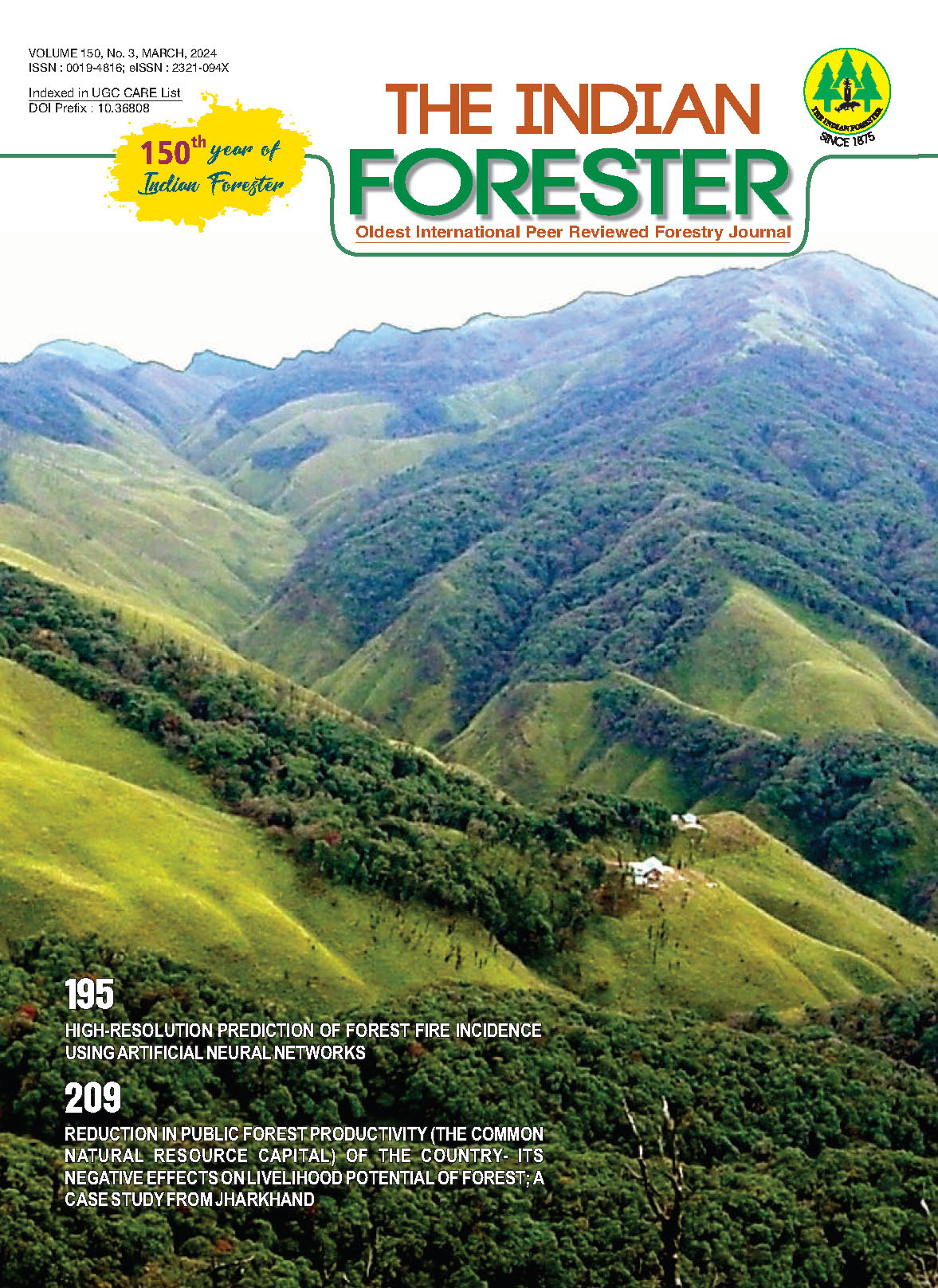Assessment of Growth and Survival Rate of Plantations under the PUNCAMPA Scheme of the Ropar Division
DOI:
https://doi.org/10.36808/if/2024/v150i3/169997Keywords:
Survival Percentage, Height, Collar Diameter, PUNCAMPA, Plantation.Abstract
Monitoring and analysis of the project helps to determine whether it was worth the investment or if there are better ways to accomplish things. Punjab government assigned the Forest Research Institute (FRI), Dehradun to monitor and evaluate the Punjab Forest Department's CAMPA activity. To meet the scheme's objectives, planting must be regularly monitored and reviewed in Ropar Division. GPS-assisted survey was conducted at each of the sites to confirm the area. Forest Research Institute, Dehradun observed and analyzed PUNCAMPA(2019-22) three-year plantations between February and March 2023 at the studies allocated areas. Representative sample plots were randomly chosen in all Forest Ranges. Monitoring locations included are 100% of the plantation's area and 10% of each sample site. Maximum height and collar diameter was recorded in Tectona grandis (3.10 m, 5.45 cm) in 2019-20 plantation, Pongamia pinnata (1.89 m, 4.10 cm) in 2020-21 and Pongamia pinnata recorded highest collar diameter (4.63 cm) and Acacia catechu having maximum height (2.93 m) in 2021-22 plantation. Highest Survival Percentage was found in Nurpur Bedi range in all three years plantation ie 74.03% in 2019-20, 73.19% in 2020-21 and 74.51 in 2021-22 followed by Ropar and Shri Chamkaur Sahib Range. Thus, this monitoring and evaluation will aid policymakers and State Forest Department in their decision-making for better plantation measures for their future management.References
Bhattacharya P. and Joshi B. (2000). A Case Study on Forest and Displaced People: Fuelwood Collection and Trade as a First Step Survival Strategy, Indian Institute of Forest Management, Bhopal and RWEDP, FAO Regional Office for Asia and the Pacific, Bangkok.
Census of India. (2011). Census of India. http://Censusindia. gov.in/ 2011census/hio/data_sheet/india/HLO_indicator.xls. Accessed on 28th April, 2014.
Chamshama S.A.O., Nwonwu F.O.C., Lundgren B. and Kowero G.S. (2009). Plantation Forestry in Sub Saharan Africa: Silvicultural, Ecological and Economic Aspects. Discovery and Innovation, 21(3): 42-49.
DoSTEN, (2012). Punjab State Action Plan on Climate Change, Department of Science, Technology & Environment and Non-Conventional Energy, Government of Punjab.
FRI (ICFRE) Dehradun (2020). Monitoring and evaluation for plantations raised under Punjab compensatory Afforestation fund management and planning authority (PUNCAMPA) during the year 2017-18 and 2018-19.
Green Growth and Forestry in Punjab (2015). Department of Science, Technology and Environment, Government of Punjab. Final Report Supported by Global Green Growth Institute.
Hertberg R., Arndt T.C. and Sekhar N.U. (2000). Fuel Wood Consumption and Forest Degradation: a household model for domestic energy substitution in rural India, Land Economics, 70(2): 213-232.
MoEF. (2006). Report of the National Forest Commission. New Delhi, India: Ministry of Environment & Forests, Government of India.
Siry J., Cubbage F. and Ahmed M.R. (2005). Sustainable forest management: Global trends and opportunities. Forest Policy and Economics, 7(4): 551-561.
Tesfaye M.A., Bravo F., Ruiz-Peinado R., Pando V. and Bravo-Oviedo A. (2016). Impact of changes in land use, species and elevation on soil organic carbon and total nitrogen in Ethiopian Central Highlands. Geoderma, 261: 70-79.
Vadrevu K.P. and Justice C. (2012). University of Maryland College Park. Biomass burning emissions in Indo-Ganges and uncertainties. Maryland, USA. MoEF, Government of India. (2013). Diversion of forest land and Compensatory Afforestation. Report No. : 21 of 2013. Compensatory Afforestation in India.
Downloads
Downloads
Published
How to Cite
Issue
Section
License
Unless otherwise stated, copyright or similar rights in all materials presented on the site, including graphical images, are owned by Indian Forester.





